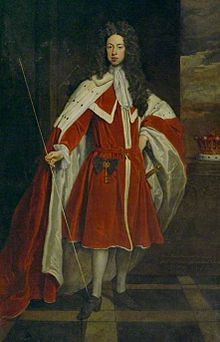Henry Grey, 1st Duke of Kent
|
His Grace The Duke of Kent KG PC |
|
|---|---|
 |
|
| Lord Chamberlain | |
|
In office 1704–1710 |
|
| Preceded by | The Earl of Jersey |
| Succeeded by | The Duke of Shrewsbury |
| Lord Steward of the Household | |
|
In office 1716–1718 |
|
| Preceded by | The Duke of Devonshire |
| Succeeded by | The Duke of Argyll |
| Lord Privy Seal | |
|
In office 1719–1720 |
|
| Preceded by | The Duke of Kingston |
| Succeeded by | The Duke of Kingston |
Henry Grey, 1st Duke of Kent, KG PC (1671 – 5 June 1740) was a British politician and courtier.
He was a son of Anthony Grey, 11th Earl of Kent, and Mary Grey, 1st Baroness Lucas of Crudwell. He succeeded his father as 12th Earl of Kent in 1702, having succeeded his mother as 2nd Baron Lucas earlier the same year. He was the grandfather, through his daughter Anne Grey, of Henry Cavendish, the preeminent English chemist and physicist of the late 18th century.
Having taken his seat in the House of Lords and though regarded as lacking talent and ambition he, as the politically expedient candidate, was made Lord Chamberlain and a Privy Counsellor in 1704. Unpopular, Grey was nicknamed Bug for his body odour. In 1710 he traded his position for a Dukedom and was succeeded as Lord Chamberlain by the Duke of Shrewsbury. It should be noted that contemporary commentators including John Macky and Jonathan Swift did defend Grey. He may have been, for his time, the right man in the right place.
After 1710 he served in politically minor positions: lord of the bedchamber, constable of Windsor Castle, lord steward of the household from 1716 until 1718, and lord keeper of the privy seal from 1719 until 1720. Grey was one of the Lords Justices appointed during the absence of George I of Great Britain.
...
Wikipedia
